Smithsonian Environmental Research Center: Addressing Environmental Challenges of the 21st Century
By M.A. Cashman, PhD
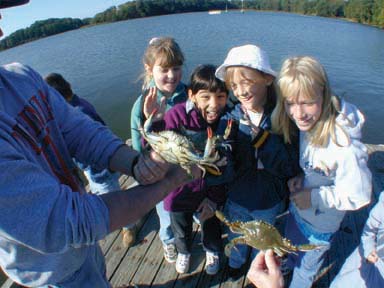
Great gifts are like seeds planted to nurture one generation, only to flourish and serve future generations. Our country received such a gift from James Smithson (1765-1829), a wealthy British scientist and member of the prestigious Royal Society of London. Born in France, Smithson became a naturalized British citizen around the age of ten. An Oxford graduate, he pursued the natural sciences, establishing a reputation as a chemist and mineralogist, and publishing papers covering a diverse range of scientific topics. A rigorous researcher, Smithson frequently had to brave the elements, as he collected mineral samples from European countries and kept accurate accounts of his experiments. Smithson never visited the United States, but in 1826, in his Last Will and Testament, he directed that his estate go "to the United States of America, to found at Washington, under the name of the Smithsonian Institution, an establishment for the increase and diffusion of knowledge...." This bequest included a collection of minerals and his scientific library.
Smithson's seminal gift establishing the Smithsonian Institution continues to flourish. In the past 50 years, the number of employees has grown from 510 to 6,300, and the number of museums from six to eleven. In the spirit of intelligent growth through research, Smithson's gift has inspired others, like Robert Lee Forrest of Baltimore.
 In 1964 Forrest bequeathed his 365-acre Java dairy farm in southern Anne Arundel County on the Rhode River, a sub-estuary of the Chesapeake Bay, to the Smithsonian Institution. Once the land was found to host a variety of habitats for terrestrial, wetland, and estuarine field biology and ecology, the site became a center for environmental research. For forty years, the center has worked towards environmental literacy, fostering public understanding of the issues and encouraging active participation in solutions to sustain life on earth. In accordance with its mission statement: In 1964 Forrest bequeathed his 365-acre Java dairy farm in southern Anne Arundel County on the Rhode River, a sub-estuary of the Chesapeake Bay, to the Smithsonian Institution. Once the land was found to host a variety of habitats for terrestrial, wetland, and estuarine field biology and ecology, the site became a center for environmental research. For forty years, the center has worked towards environmental literacy, fostering public understanding of the issues and encouraging active participation in solutions to sustain life on earth. In accordance with its mission statement:
The Smithsonian Environmental Research Center (SERC) leads the Nation in research on linkages of land and water ecosystems in the coastal zone, and provides society with knowledge to meet critical environmental challenges in the 21st century.
During the 60s, the site was named the Chesapeake Center for Field Biology and grants from foundations and others were used to acquire additional land. Initially the site was used for field collection only.
Then in the 70s, about 15 scientists from the Smithsonian, the USGS and local universities conducted research that took the form of published articles in scientific journals. With continued land acquisition and increased field workers, there was a need for a resident scientific staff. Jim Lynch, Ph.D. in Biology, the first resident scientific staff member, began the terrestrial animal ecology program that continues today. Another longitudinal study, Plant Physiologist Bert Drake's work on tidal marsh plant communities, is the longest running field study on the effects of atmosphere CO2 in the world. Today the center is home to 17 senior scientists and supports a team of more than 180 researchers, technicians, and students who work on the 2,800-acre site and at field stations around the world.
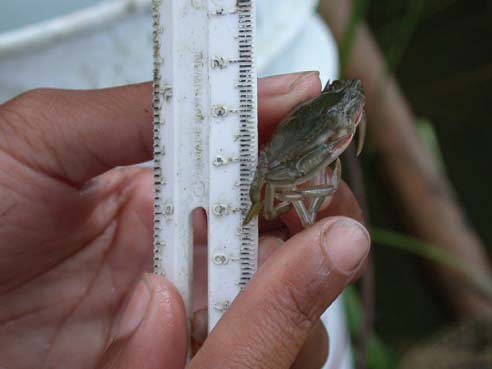 In the 80s, the center officially became the Chesapeake Environmental Research Center (SERC). It was also the beginning of a public education program, with the self-guided Discovery Trail and Java History Trail and the guided Muddy Creek canoe trips and marsh explorations. Today SERC takes students and teachers on a forty-two foot research vessel, the V/V Saxatilis for water quality sampling, plankton sampling, trawling, and benthic sampling. In the 80s, the center officially became the Chesapeake Environmental Research Center (SERC). It was also the beginning of a public education program, with the self-guided Discovery Trail and Java History Trail and the guided Muddy Creek canoe trips and marsh explorations. Today SERC takes students and teachers on a forty-two foot research vessel, the V/V Saxatilis for water quality sampling, plankton sampling, trawling, and benthic sampling.
In the 90s, the research on the Rhode River and the Chesapeake Bay went global as the Bay became a model for the complex environmental issues facing the world. Today SERC maintains an extensive library on environmental research and the Chesapeake Bay area; its scientists conduct studies throughout the world and a cadre of international scientists visits SERC annually.
SERC achievements include 1,100 scientific publications in technical journals and books, $20,000,000 in grants and contracts funded from government agencies, foundations, and industry, a 40-year history of excellence in research and education on human impacts in land-sea interactions of the coastal zone, and a key leadership role in developing the Marine Science Network for comparative coastal studies. Moreover, there is a SERC Leadership Center, dedicated to the training and development of the next generation of environmental scientists. Since 1971, the center has trained 786 interns and 460 post doctoral, pre-doctoral, and graduate student fellows.
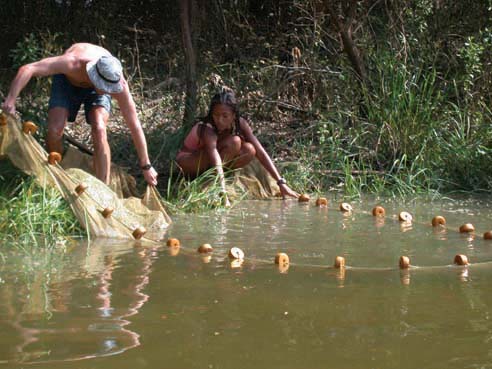 The source of far-reaching research on environmental management and sustainability in the development of the United States. SERC is the Nation's leading research and education center for understanding and solving contemporary environmental issues. It may also be one of the best-kept secrets in the greater Annapolis area, but SERC Director Ross Simons and staff, including Science Writer/Editor Kimbra Cutlip, are working to change that image. The source of far-reaching research on environmental management and sustainability in the development of the United States. SERC is the Nation's leading research and education center for understanding and solving contemporary environmental issues. It may also be one of the best-kept secrets in the greater Annapolis area, but SERC Director Ross Simons and staff, including Science Writer/Editor Kimbra Cutlip, are working to change that image.
Their public service and outreach efforts include education programs, monthly lectures, conferences and special events such as the Annual Open House for Nature held this year on Saturday, May 7. Activities for all ages included hayrides, crafts, face painting, and viewing the forest canopy from the basket of a crane. Visitors met with scientists for staff-guided tours of the labs and research sites not generally accessible to the public. Except for the Open House, food is not available for sale on site. Visitors are welcome to picnic or bring their lunch year round. Also, because SERC is an active research site, visitors may not bring pets or use the docks for boating or swimming.
Education programs are tailored for K-12 students, college students, teachers, and the general public. These include summer camps for students to enjoy a week of learning and discovery with hands-on science activities such as checking water quality and catching their own fish and crabs. For 9th graders, the Summer Star is a program for aquatic research; for 6th to 8th graders, the Ecosystem Adventure is the study of wetlands, forests, creeks, rivers, plants and animals; for 4th and 5th graders, Environmental Detectives is an investigation of the mystery and diversity of life in the wetlands of the Chesapeake; and for 3rd graders, the Wild Wonderful Wetlands is a discovery of the diversity of life in the Chesapeake Bay watershed.
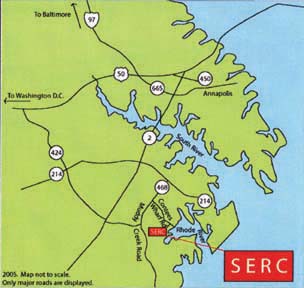 Monthly lectures are held on-site, are open to the public, and cover environmental science topics, such as the strong connection between development near watersheds and PCB levels in fish. There are also distance learning programs that reach up to 20 million students per year. Public awareness is increasing the number of visitors to SERC. Once aware of SERC, many return for special programs and lectures; many others decide to volunteer. Monthly lectures are held on-site, are open to the public, and cover environmental science topics, such as the strong connection between development near watersheds and PCB levels in fish. There are also distance learning programs that reach up to 20 million students per year. Public awareness is increasing the number of visitors to SERC. Once aware of SERC, many return for special programs and lectures; many others decide to volunteer.
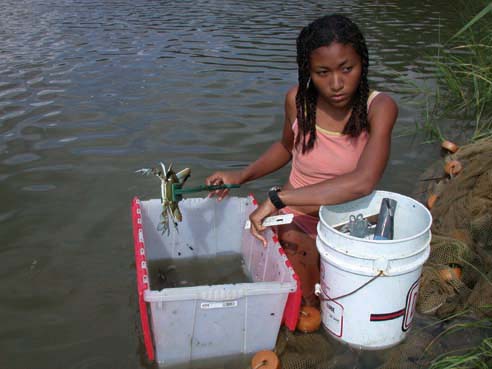 Volunteers will find a variety of positions available in education and research. Those who wish to work with young children may sign up at the Education Department in the Reed Building. Available positions include canoe guides, nature guides, and field trip assistants. Some assistants work with elementary students in the outdoor Estuary Chesapeake program; others work with middle and high school students in the outdoor Marsh Explorations program. Volunteers will find a variety of positions available in education and research. Those who wish to work with young children may sign up at the Education Department in the Reed Building. Available positions include canoe guides, nature guides, and field trip assistants. Some assistants work with elementary students in the outdoor Estuary Chesapeake program; others work with middle and high school students in the outdoor Marsh Explorations program.
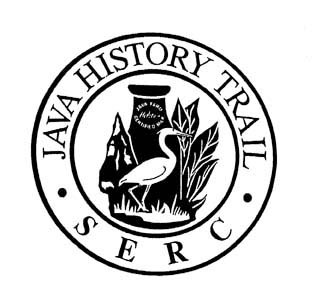 Volunteers interested in research programs may be interested in the Blue Crab Enhancement Project. Radio tags and magnetic wire enable researchers to monitor baby female crabs as they migrate to spawn, compiling data that will help provide sound facts for decision-makers faced with the problem of the decline of the blue crab in the Chesapeake Bay. Or, volunteers may prefer to explore the stream monitoring stations for stream sampling, where researchers fish the weir in the river regularly during the season, monitoring everything going in and out; or, in the riparian buffer zones that trap nutrients. If interested in the bio-complexity in mangrove communities, contact Ilke Feller at: Felleri@si.edu or Peter Marra, who invites citizen participation in monitoring birds, at: www.nestwatch.si.edu. If interested in plant ecology, there is the orchid research of Melissa McCormick who monitors the green orchid and other local varieties to determine if the relationship between flora and fungus is species-specific. Those who volunteer enjoy benefits such as the regular "lunch with a scientist" event. Volunteers interested in research programs may be interested in the Blue Crab Enhancement Project. Radio tags and magnetic wire enable researchers to monitor baby female crabs as they migrate to spawn, compiling data that will help provide sound facts for decision-makers faced with the problem of the decline of the blue crab in the Chesapeake Bay. Or, volunteers may prefer to explore the stream monitoring stations for stream sampling, where researchers fish the weir in the river regularly during the season, monitoring everything going in and out; or, in the riparian buffer zones that trap nutrients. If interested in the bio-complexity in mangrove communities, contact Ilke Feller at: Felleri@si.edu or Peter Marra, who invites citizen participation in monitoring birds, at: www.nestwatch.si.edu. If interested in plant ecology, there is the orchid research of Melissa McCormick who monitors the green orchid and other local varieties to determine if the relationship between flora and fungus is species-specific. Those who volunteer enjoy benefits such as the regular "lunch with a scientist" event.
Whether interested in volunteering or just being there for a while, in the SERC environment amid forest, cropland, pasture, freshwater wetlands, tidal marshes, it is well worth the time to make that first visit. Where else can you visit with pileated woodpeckers, brown tree snakes, mute swans, turkeys, deer - and perhaps other site residents.
To visit SERC, take Route 2 south, left on 214, right onto Muddy Creek Road (468), and a left onto Contees Wharf Road. Soon you will be on almost a mile of gravel road through Maryland farmland: rolling, dormant fields and patches of woods - some neatly trimmed and others rich in deadfall for insect and small animal homes. At the end of the road, turn right onto an asphalt road marking the entrance to SERC, the Smithsonian Environmental Research Center.
There you will experience how a great research gift is flourishing in Edgewater, and through your interest and involvement, before long, SERC won't be a secret any more.
For additional information and program details: www.SERC.si.edu.
Back
|

